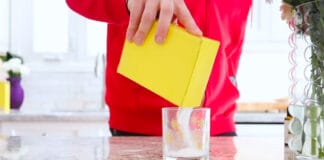I kept seeing videos of people using fancy cast iron pans. I really wanted to get in on the action, specifically because I didn’t want to use non-stick pans. So, I did a lot of research and I want to share with you my 10 favourite tips on how to get into cooking successfully with cast iron. If you care for them well, you can hand them down and your grandkids
Season the pan – before you start using your pan, you have to season it (if it is not seasoned already). My La Crueset pans were pre-seasoned, but if yours aren’t, you need to season them. Seasoning essentially makes the pan non-stick and you want to do this to make your cooking easier as well as to preserve the life of your pan. To do it, simply: BLA.
Heating the pan – you need to heat your pan for about 10 minutes before using it, it takes longer to spread the heat around than a stainless steel pan, but it is worth the wait. Because it takes longer, the heat retains better in the pan and spreads evenly. I splash water in the pan and when it evaporates on contact, it’s good to go.
How hot do you go? Even if recipes call for high heat, I never heat this pan over medium on my stovetop. If you go to high heat you can warp the base of the pan, which will not allow it to cook evenly. That would be pretty awful, especially if you spent good money on your pan. Because cast iron retains and distributes heat so well, it’s fine to go to medium. If your pan develops an ashy layer as it is heating, you’ve gone too hot and the pan will warp.
Utensils – use wood or silicone utensils specifically designed for high-heat, plastic ones will melt and metal ones can ruin the pan.
Glass stove top – yes, you can use these on glass cooktops, you just have to be careful because they are heavy and if you drop it you can crack your stovetop given the weight of the pan. While I’ve never had the pleasure of cooking on a gas stove top, they heat just fine for me on my glass one. Also, be mindful to have a clean bottom of your pan and a clean cooktop before cooking to avoid stains and marks on the glass surface.
Touching the handle – this may come as a shocker to you, but you need to wear a glove or have a little handle cover when using a cast iron pan, even when stovetop cooking. The handle conducts heat too and becomes extremely hot. Don’t experiment with this, take my word for it.
Stovetop to oven – this is one of the coolest things about these pans, they can go right into the oven and then to the table, of course with appropriate protection like a trivet and a handle cover. Just don’t place inside the oven over 450 degrees to ensure you don’t overheat the iron and warp the pan. This is super duper cool.
Searing – this is an overwhelming experience for beginners. Make sure your overhead exhaust is on and your windows are open, you’re going to get a lot of smoke. Now I’m not a professional cook by any means, but I do know you are going to get a lot of smoke so just prepare. Heat your pan, to reduce smoking you can use grape seed oil which has a higher smoke point than olive oil, and do your bidding. Whatever you are cooking, place into the pan and leave it. If you want to develop that amazing crust on the bottom, you need to leave it for a few moments until that crust is naturally formed. Don’t touch it and avoid temptation. When your food has formed its crust, it will easily slide around, as if it were in a non-stick pan. If it is still sticky and it breaks apart, it hasn’t fully cooked through yet and is not ready to be flipped. Play with this and you’ll learn, that’s what I had to do. When it has popped off the bottom of the pan, at that point, you can flip it over. While you are leaning this technique, stand by the pan and just experiment. If you do it right, you can sear a whole fish filet perfectly without it breaking.
Cleaning – These are easier to clean that you would imagine. The oils and grease from cooking continue to season the pan through creating a patina, which may sound gross but I assure you it is not. Remember, you are cooking with heat so anything you are scared of will be killed during heating anyway. Let the pan cool down, but when it is warm enough to touch, take a paper towel and give it a good wipe to remove debris. It should be a bit greasy still, that’s fine. Just get the crusty bits out. And that’s all, no water, no nothing. If you do need to clean the pan with soap and water, what you can do is simmer some water over medium heat, add a squirt of dish soap and a sprinkle of kosher salt. Use a wooden spoon to push around the salt and ‘scratch’ off any debris. Dump the water, wipe out the pan with a paper towel immediately. Easy and safe. Don’t do this all the time because you will remove that valuable patina.
Storage – Never, ever, leave or store your pan wet. You can’t soak these overnight. It will rust! Ensure it is always dry and stored in a cool, dry place.
I hope that helps you get started with using cast iron, I simply love mine and once you understand how to properly use and care for them, you will to!
What are your favourite cast iron use and care tips?
Looking for a BETTER & EASIER Way to Clean Your Home?
Cleaning Expert Melissa Maker is here to help with her game-changing 3 Wave Cleaning System that will help you clean your house faster and easier than you ever thought possible!
















